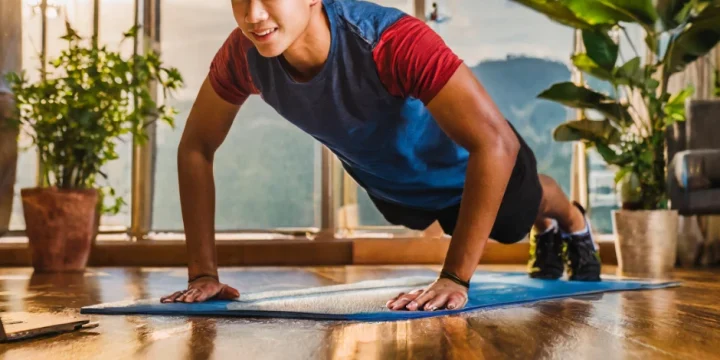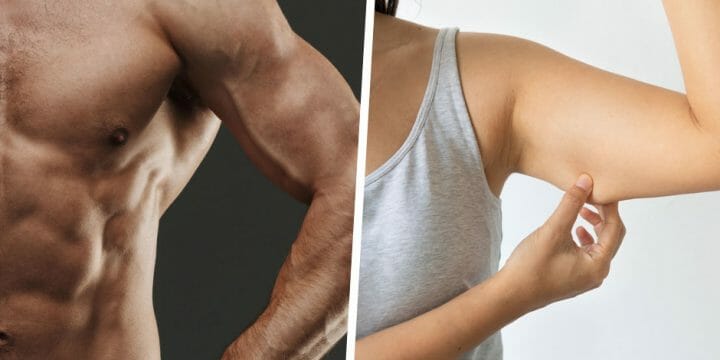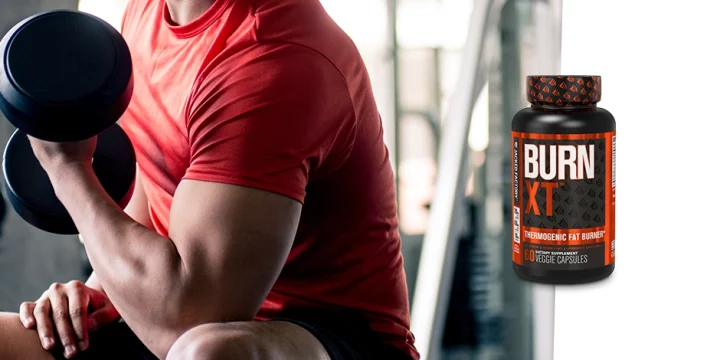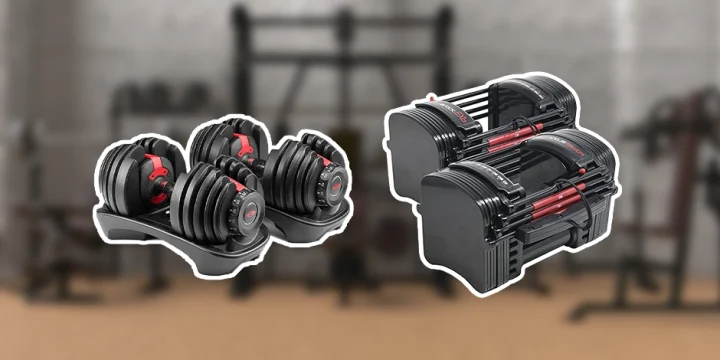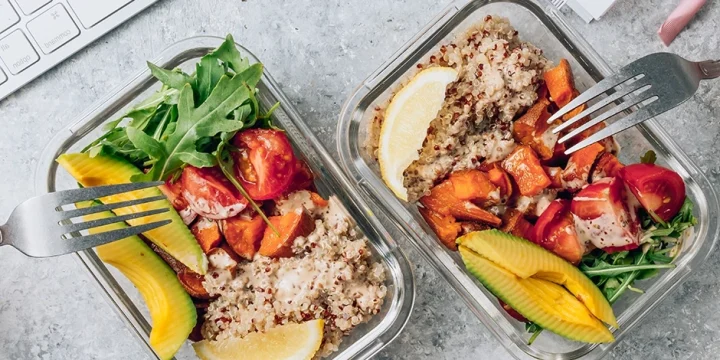When it comes to fat burning, every person with elementary knowledge about fitness knows that strength training plays an important role in losing weight.
Some of the most common questions my clients ask me revolve around how many reps are optimal for weight loss.
Since that depends on so many different factors, I conducted in-depth 3-week research to find the science and experts say.
Check out my findings.
Quick Summary
- For effective fat loss, aim for a rep range of 8-12, combining high reps with heavy lifting and cardio to maintain a metabolically active body.
- Advanced fitness levels can benefit from high rep training, which involves pushing to muscle failure with light to moderate loads for body fat reduction.
- A study by Harvard Medical School notes that half an hour of vigorous-intensity strength training can burn between 180 to 266 calories.
- Personally, I find that balancing high-rep workouts with strength training and cardio is the most effective approach for sustained fat loss.
How Many Reps Should You Aim for Fat Loss?

You should aim for 8-12 repetitions for fat loss. However, this number depends on the factors like your fitness level and how you perform the reps.
Generally, a number of reps higher than 12 is believed to stimulate muscle fibers that provide endurance; 6-12 reps should trigger muscle hypertrophy, whereas 1-5 reps are considered to stimulate muscle fibers that create strength.
The number that is optimal for weight loss depends on your fitness level, above all.
Novice
If your fitness level is a novice, you should opt for one to three sets of eight to 12 repetitions - a number the Department of Health and Human Services (HHS) recommends [1].
You should perform this by hitting major muscle groups (arms, legs, core, chest, and back) twice a week, avoiding training the same muscle groups daily, and providing them a full-day rest.
Advanced
From my experience coaching many people, I've learned that high rep training isn't just about sticking to light weights and a rigid set of reps. It's about challenging your limits.
I often mix it up, sometimes going beyond the recommended reps or increasing the weight to keep my muscles guessing.
It means you should train (almost) to failure hitting higher rep thresholds with light to moderate loads to reach the goal of effective body fat loss.
Those high reps usually count between 10-20, extending even to the 20-30 range. This high reps number requires a load that leads to muscular failure.
Therefore, if you choose a weight that allows you to do more than 30 reps without failure, you are probably using too light of a weight that probably won’t provide optimal benefits.
What Are the Drawbacks?

I've personally feel lifting weights for fat burn with high reps can be both debilitating and challenging. It's a journey filled with ups and downs. Preparing mentally for this challenge is crucial.
More reps mean more time consumed, more concentration required, and more sweat produced.
While it’s easy to perform fewer reps correctly, the burn you experience reaching the 20th or 30th rep challenges your concentration and form, making you want to quit.
Therefore, to prevent this, your workout plan shouldn’t consist solely of light weights and high reps to lose weight.
Should I Combine High Reps With Other Workout Plans?

You should combine high reps with other workout plans like low-rep heavy weights or cardio since they can support your metabolism and help you avoid the plateau.
Strength Training Combination
Training that combines lifting heavy weights and lighter weights may be an even more effective combination to burn fat.
Light Weight
Lifting lighter weights in high reps will build muscular endurance, while heavier weights will help you build strength and preserve muscle mass.
If you aren’t a novice, you could make this combination by performing drop sets or supersets where reaching the higher rep range is achieved by starting with a heavy weight for moderate reps and then switching to a lower weight once you reach failure.
Heavy Weight
This weight training program will keep you in high-intensity condition for a more extended period to generate a strong metabolic demand and muscle hypertrophy simultaneously.
One study from the International Journal of Clinical Medicine suggests that low load high repetitions and heavy load low reps are evenly effective when the intensity of high load resistance training is pulled near or to technical failure [2].
Advantages
Lifting weights as part of your exercise program can be really advantageous when it comes to reducing weight. Weightlifting not only helps with strength and muscle mass preservation, but it also helps with calorie burning.
Resistance exercises, whether with your own body weight or external weights, can enhance muscle building and increase metabolism, resulting in a larger potential for weight loss.
Combining weightlifting with other forms of exercise, such as aerobic activities or bodyweight exercises, might help you achieve your weight loss goals even faster. So, if you want to reduce weight and enhance your general fitness, consider including weight lifting into your workout the training.
“Ideally, I suggest weight training three times per week, as this frequency has been shown to be an effective strategy when it comes to muscle building and fat loss.”
- Eric Bowling, CPT, Personal Trainer at Ultimate Performance
Overall, lifting is an excellent way to lose weight as half an hour of lifting can burn from 90 to 133 calories. A study by Harvard Medical School notes that vigorous-intensity strength training can burn even more, ranging from 180 to 266 calories in half an hour [3].
Related: Best Exercises for Losing Weight
Cardio Combination

Adding cardio to my strength training was a real game-changer. It gave my muscles the rest they needed. Balancing both, I saw better fat loss and more varied, exciting workouts.
With cardio, muscles rest differently than with strength training, letting you torch calories while giving certain muscles a break.
But, watch out – too much cardio can mess with your muscle mass, strength, and how well you hold onto muscle, not just fat.
“Cardio can be done every day if it’s low-intensity; the higher the intensity, the less frequently you can perform it.”
- Eric Bowling, CPT, a personal trainer at Ultimate Performance
According the Journal of Strength and Conditioning Research, the best type of cardio would be a quick HIIT cardio workout for fat loss that can increase aerobic performance and explosiveness while preserving or building lean muscle mass [4].
Long-Term Sustainability and Adaptation
Observing my body's response to varied rep ranges is fascinating. Lower reps boost strength and muscle growth, preventing fat loss plateaus.
Incorporating exercises targeting multiple muscles enhances calorie burn and muscle maintenance. Cardio ensures overall health and calorie burn. Adequate protein is crucial for muscle retention during calorie cuts. Consistency, gradual progression, and smart nutrition are key for sustained fat loss.
Impact of Different Types of Muscle Fibers
Different rep ranges uniquely affect muscle fibers.
High reps, typical in endurance workouts, work slow-twitch fibers, boosting stamina and burning fat over time. Low reps, seen in strength training, target fast-twitch fibers, increasing muscle size and strength.
Both types help burn fat by raising your overall calorie burn. Mixing rep ranges leads to better muscle adaptability and metabolic flexibility, aiding in both fat loss and endurance.
FAQs
Should I Do More Reps or More Weight For Fat Loss?
For fat loss, it’s almost equally important to lift heavy with low reps and light weights with high reps as both types contribute to the goal in a specific way.
Lifting heavy weights will help you retain energy-hungry muscles and maintain strength as much as you can while in the cutting phase, whereas lifting high reps with light weights will help you lower your body fat percentage and look leaner.
Is 20 Reps Too Much?
Around 20 reps and anything greater than that number of reps may be considered too much except for beginners who are getting used to proper exercise form.
In all other cases, 20 reps will probably have diminishing results or be a sign that you are using too light of a weight.
References:
- https://health.gov/sites/default/files/2019-09/Physical_Activity_Guidelines_2nd_edition.pdf
- https://www.scirp.org/html/28182.html
- https://www.health.harvard.edu/diet-and-weight-loss/calories-burned-in-30-minutes-for-people-of-three-different-weights
- https://journals.lww.com/nsca-jscr/Fulltext/2010/03000/Relationship_Between_Anthropometric_and.9.aspx
About The Author
You May Also Like
